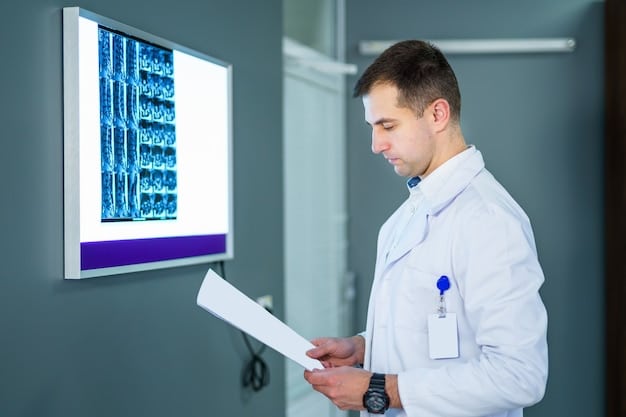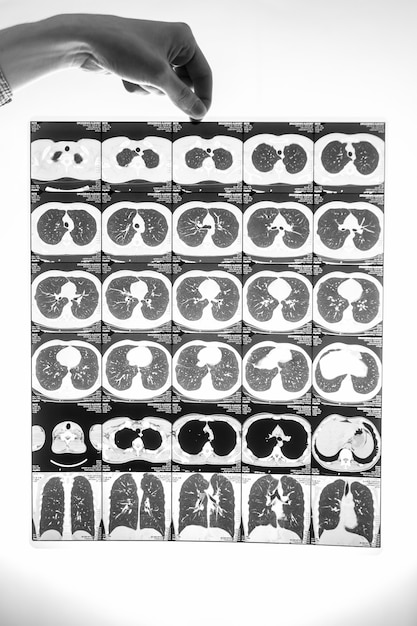Machine Learning for Healthcare: Accurate Disease Diagnosis

Machine learning is transforming healthcare by providing highly accurate disease diagnoses, reaching up to 95% accuracy in some applications, enhancing the speed and precision of medical decisions.
Machine Learning for Healthcare: Diagnosing Diseases with 95% Accuracy is rapidly changing the landscape of medical diagnostics, offering unprecedented precision and efficiency. By leveraging sophisticated algorithms and vast datasets, machine learning is enabling healthcare professionals to identify diseases earlier and more accurately, ultimately improving patient outcomes. Let’s explore how this technology is revolutionizing the medical field.
The Rise of Machine Learning in Healthcare
Machine learning (ML) has emerged as a powerful tool in various sectors, and healthcare is no exception. Its ability to analyze complex datasets and recognize patterns has made it invaluable in improving diagnostic accuracy and efficiency. As healthcare systems grapple with increasing workloads and the need for precision, machine learning is providing much-needed support.
The integration of machine learning into healthcare is not just about improving existing processes; it’s about creating new possibilities for personalized medicine and preventative care. Let’s delve into the specifics of how machine learning achieves such high accuracy in disease diagnosis.
Key Advantages of Machine Learning in Diagnostics
Machine learning offers several advantages over traditional diagnostic methods. Its ability to process large amounts of data and identify subtle patterns that humans might miss is particularly significant. Some key benefits include:
- Enhanced Accuracy: ML algorithms can achieve up to 95% accuracy in certain diagnostic applications.
- Improved Efficiency: Automated analysis reduces the time required for diagnosis, allowing for faster treatment.
- Personalized Medicine: ML can tailor treatments based on individual patient data, leading to better outcomes.
- Early Detection: ML algorithms can identify diseases at earlier stages, when treatment is often more effective.
These advantages are driving the adoption of machine learning solutions across various medical specialties, from radiology to cardiology.

How Machine Learning Achieves 95% Accuracy
The impressive 95% accuracy rate in disease diagnosis through machine learning is the result of several key factors. These include the types of algorithms used, the quality and quantity of training data, and the specific applications for which these systems are designed.
Understanding these factors is crucial for appreciating the potential and limitations of machine learning in healthcare. Let’s examine the specific elements that contribute to such high accuracy.
The Role of Algorithms
Different machine learning algorithms are suited for different diagnostic tasks. Some of the most commonly used algorithms in healthcare include:
- Deep Learning: Neural networks that excel at image recognition and natural language processing.
- Support Vector Machines (SVM): Effective for classification tasks, such as distinguishing between different types of tumors.
- Random Forests: Ensemble learning methods that combine multiple decision trees to improve accuracy and reduce overfitting.
- Logistic Regression: A statistical method used for predicting the probability of a particular outcome, such as the presence of a disease.
The choice of algorithm depends on the nature of the diagnostic problem and the type of data available. Deep learning, for example, is often used for analyzing medical images, while SVM is used for classifying genetic data.
The Importance of Training Data
The accuracy of machine learning models is heavily dependent on the quality and quantity of training data. Models are trained using labeled datasets, where the correct diagnosis is already known. The more comprehensive and representative the training data, the better the model will perform.
High-quality training data should include:
- Large Sample Size: A sufficient number of cases to ensure the model can generalize well.
- Diversity: Cases representing different demographics, disease stages, and comorbidities.
- Accurate Labels: Diagnoses confirmed by expert physicians to minimize errors.
- Clean Data: Data that has been preprocessed to remove noise and inconsistencies.
Without robust training data, machine learning models are prone to overfitting, where they perform well on the training set but poorly on new, unseen data.
Specific Applications of Machine Learning in Disease Diagnosis
Machine learning is making significant strides in the diagnosis of various diseases. Its applications range from detecting cancer in medical images to predicting heart disease based on patient data. These applications are improving patient outcomes and transforming clinical practice.
By automating and enhancing diagnostic processes, machine learning is allowing healthcare professionals to focus on patient care and treatment planning. Let’s explore some specific examples.
Cancer Detection
Machine learning is proving to be highly effective in cancer detection, particularly in analyzing medical images such as mammograms, CT scans, and MRIs. Algorithms can identify subtle anomalies that might be missed by human radiologists.
For example, deep learning models have achieved high accuracy in detecting breast cancer from mammograms, reducing the rate of false positives and false negatives. Similar techniques are being used to detect lung cancer, skin cancer, and other types of cancer.
Cardiovascular Disease Diagnosis
Machine learning is also being used to diagnose and predict cardiovascular diseases. By analyzing patient data such as blood pressure, cholesterol levels, and ECG readings, algorithms can identify individuals at high risk of developing heart disease.
ML models can also assist in the diagnosis of heart conditions such as arrhythmias and heart failure. These models can analyze ECG data to detect abnormal heart rhythms and predict the likelihood of heart failure based on various risk factors.
Neurological Disorders
The diagnosis of neurological disorders, such as Alzheimer’s disease and Parkinson’s disease, often involves complex clinical assessments and imaging studies. Machine learning can help streamline this process and improve diagnostic accuracy.
ML algorithms can analyze MRI scans to detect early signs of brain atrophy associated with Alzheimer’s disease. They can also analyze patient data to predict the likelihood of developing Parkinson’s disease based on genetic and environmental factors.

Challenges and Limitations
Despite its potential, machine learning in healthcare faces several challenges and limitations. These include issues related to data privacy, ethical concerns, and the integration of machine learning systems into clinical workflows. Addressing these challenges is crucial for realizing the full potential of machine learning in healthcare.
Overcoming these hurdles will require collaboration between healthcare professionals, data scientists, and policymakers. Let’s discuss some of the key challenges in detail.
Data Privacy and Security
The use of machine learning in healthcare requires access to large amounts of sensitive patient data. Protecting patient privacy and ensuring data security are paramount.
Measures to address these concerns include:
- Data Anonymization: Removing personal identifiers from datasets to protect patient privacy.
- Secure Data Storage: Storing data in secure, encrypted databases to prevent unauthorized access.
- Data Governance Policies: Implementing policies that govern how data is collected, stored, and used.
Compliance with regulations such as HIPAA (Health Insurance Portability and Accountability Act) is essential for maintaining patient trust and ensuring the responsible use of data.
Ethical Considerations
The use of machine learning in healthcare raises several ethical considerations. These include issues related to algorithmic bias, transparency, and accountability.
To address these ethical concerns, it is important to:
- Mitigate Bias: Ensure that training data is representative of the population to avoid algorithmic bias.
- Promote Transparency: Make the decision-making processes of machine learning models transparent and understandable.
- Establish Accountability: Define clear lines of responsibility for the outcomes of machine learning-based diagnoses and treatments.
Ethical guidelines and regulatory frameworks are needed to ensure that machine learning is used responsibly and ethically in healthcare.
Integration into Clinical Workflows
Integrating machine learning systems into existing clinical workflows can be challenging. Healthcare professionals need to be trained on how to use these systems and interpret their results.
To facilitate integration, it is important to:
- Provide Training: Offer comprehensive training programs for healthcare professionals on the use of machine learning tools.
- Develop User-Friendly Interfaces: Design interfaces that are intuitive and easy to use.
- Ensure Interoperability: Ensure that machine learning systems can seamlessly integrate with existing electronic health record (EHR) systems.
Successful integration of machine learning into clinical workflows requires a collaborative effort between technology developers and healthcare providers.
The Future of Machine Learning in Healthcare
The future of machine learning in healthcare is promising. As technology advances and more data becomes available, machine learning is expected to play an even greater role in disease diagnosis, treatment planning, and preventative care. The potential for personalized medicine and improved patient outcomes is immense.
Continued research and development will drive further innovation in this field. Let’s explore some of the key trends and future directions.
Advancements in AI Technology
Advancements in artificial intelligence (AI) technology are expected to drive further improvements in machine learning accuracy and efficiency. New algorithms and techniques will enable machine learning models to analyze data more effectively and make more accurate predictions.
For example, research is underway to develop AI systems that can learn from unstructured data, such as clinical notes and medical literature. This would allow machine learning models to leverage a broader range of information sources, leading to more comprehensive and accurate diagnoses.
Expanding Applications
The applications of machine learning in healthcare are expected to expand beyond disease diagnosis. Machine learning is already being used to predict patient outcomes, optimize treatment plans, and identify individuals at high risk of developing chronic diseases.
In the future, machine learning may also be used to develop personalized prevention strategies, such as tailored diet and exercise recommendations. This would allow healthcare providers to proactively manage patient health and prevent the onset of disease.
Personalized Medicine
Machine learning is poised to revolutionize personalized medicine. By analyzing individual patient data, machine learning models can identify the most effective treatments for each patient. This approach takes into account genetic factors, lifestyle factors, and other individual characteristics to tailor treatment plans to the specific needs of each patient.
Personalized medicine has the potential to improve treatment outcomes, reduce side effects, and lower healthcare costs. Machine learning is a key enabler of this approach, providing the tools needed to analyze complex patient data and identify personalized treatment strategies.
| Key Point | Brief Description |
|---|---|
| 🩺 ML Accuracy | Machine learning achieves up to 95% accuracy in diagnosing diseases. |
| 📊 Training Data | High-quality, diverse training data is essential for accurate diagnoses. |
| ⚕️ Cancer Detection | ML enhances cancer detection via medical imaging analysis. |
| 🔒 Data Privacy | Protecting patient data is crucial for ethical ML implementation. |
Frequently Asked Questions
Machine learning algorithms can achieve up to 95% accuracy in diagnosing diseases, depending on the quality of the data and the specific application.
Key advantages include enhanced accuracy, improved efficiency, personalized medicine, and early detection of diseases, leading to better patient outcomes.
Training data includes medical images, patient records, genetic data, and clinical notes, which are used to train the models for accurate diagnoses.
Ethical considerations include data privacy, algorithmic bias, transparency, and accountability, which must be addressed for responsible implementation.
Integration involves providing training, developing user-friendly interfaces, and ensuring interoperability with existing EHR systems for seamless adoption.
Conclusion
In conclusion, machine learning for healthcare: diagnosing diseases with 95% accuracy represents a significant advancement in medical technology. While challenges remain, the potential benefits for improving patient outcomes and transforming clinical practice are undeniable. As AI technology continues to evolve, machine learning will play an increasingly vital role in the future of healthcare.





